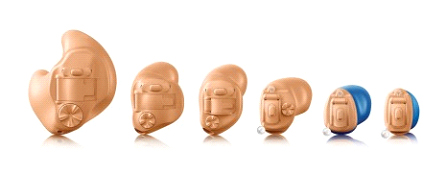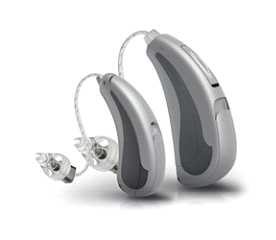A hearing aid is a small electronic device that can be placed inside the ear (CIC, ITC, ITE models) or behind the ear (BTE model), which increases the volume of sounds so that a person with hearing loss can maintain their daily communications and conversations. Additionally, hearing aids can greatly assist in understanding speech in both quiet and noisy environments.
Components of a Hearing Aid:
- Microphone
- Amplifier
- Speaker
The hearing aid receives sound through the microphone, converts it into electrical signals, and sends it to the amplifier. The amplifier increases the power of the signal and then sends it through the speaker into the ear.
How Does a Hearing Aid Help a Person with Hearing Loss?
Primarily, by amplifying sound, reducing background noise, and enhancing the clarity of speech sounds, a hearing aid improves hearing thresholds and consequently enhances the ability to comprehend speech in both quiet and noisy environments. Additionally, for many individuals, using a hearing aid prevents the progression of hearing loss and is very beneficial for those who suffer from tinnitus.
How to Recognize Hearing Loss?
If you notice a decrease in the volume of other people’s voices, difficulty using the telephone, trouble understanding television audio, difficulties in understanding speech in quiet environments especially in noisy and crowded environments, complaints from others about speaking loudly, as well as specific medication use or working in noisy environments, and aging—these are indicators. By visiting hearing clinics and evaluating your hearing system, you can learn about the presence, extent, and type of your hearing loss.
Hearing Aid Models
Hearing aids vary in price, size, specific features, and how they fit in the ear. Generally, hearing aids are seen in the following forms:
-
- In-the-ear hearing aids (CIC, ITC, ITE): These models are placed inside the ear canal and are suitable for mild to severe hearing loss.
-
- Behind-the-ear hearing aids (BTE): In this model, the hearing aid sits behind the ear and is connected to an ear mold inside the ear via a tube. This model is suitable for all ages and almost all types of hearing loss.
-
- Open Fit Hearing Aids: This type is a variation of behind-the-ear hearing aids with a thinner tube, where the receiver is placed in the ear canal. This model keeps the ear canal open, resulting in natural and higher quality sound as it allows low frequencies to enter the ear canal without amplification and amplifies the high frequencies through the hearing aid. This hearing aid is suitable for mild to severe hearing loss and is less visible, making it very useful for individuals with damaged eardrums.
Which Type of Hearing Aid is Best?
If you need a hearing aid, the best model is recommended based on the results of audiometric tests regarding the type and degree of hearing loss. Additionally, if there is hearing loss in both ears, two hearing aids should be used because this allows the sound to reach the brain more naturally, improving directional and spatial hearing abilities as well as sound perception in noisy environments.
Hearing aids do not restore normal hearing but gradually and with practice, they improve your awareness of sounds and their understanding.
How to Take Care of Your Hearing Aid?
-
- Keep the hearing aid away from heat and moisture.
-
- Clean the hearing aid as instructed by an audiologist.
-
- Avoid using hairspray while wearing the hearing aid.
-
- Turn off the hearing aid when not in use.
-
- Immediately replace depleted batteries.
-
- Keep the hearing aid and its batteries out of reach of children.




